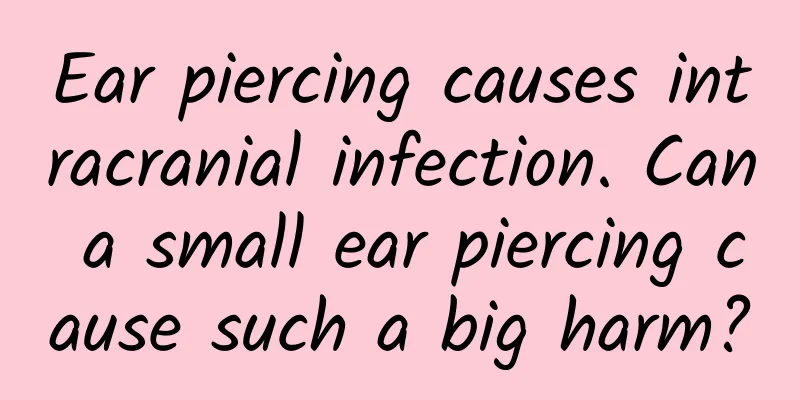What medicine should pregnant women use for conjunctivitis?

|
Pink eye that occurs in daily life is usually what we call infectious conjunctivitis. There are generally many reasons for this phenomenon. Depending on the cause of the disease, it can be divided into bacterial conjunctivitis and viral conjunctivitis. However, no matter which type of conjunctivitis it is, it needs to be treated as soon as possible, especially for pregnant women. If it is not treated in time, it will affect the growth and development of the fetus. Treatment methods for general people To treat conjunctivitis, we usually use some basic anti-inflammatory drugs. First, we need to determine whether it is an infection by viruses, bacteria or other pathogens, and then use targeted eye medications to treat it. Generally, broad-spectrum and potent antibiotics are preferred, such as fluoroquinolone antibiotics (ciprofloxacin, ofloxacin, etc.) or aminoglycoside antibiotics (gentamicin, tobramycin, etc.). In addition, tetracycline cortisone eye ointment and the like are also commonly used. Treatment for pregnant women If a pregnant woman gets conjunctivitis, it will not be transmitted to the fetus. However, conjunctivitis must be treated with medication. Medication is very bad for the baby. You can take medication as prescribed by the doctor. The treating doctor will choose the medication with the least impact based on the situation. Eat more vegetables, fruits, and protein-rich foods. Pay attention to a balanced diet and ensure balanced nutritional intake. Have regular prenatal checkups and take good care of yourself during pregnancy. In addition to receiving medical treatment, you should also learn to take care of yourself. Keep your eyes clean. Since there is a lot of eye secretions when suffering from acute conjunctivitis, you cannot rely solely on medication for treatment. It is important to take good care of your eyes and keep them clean at all times. Apply cold compress in the early stage and use steroid eye drops with caution. In the early stage of acute conjunctivitis, cold compress should be applied to the eyes to help reduce swelling and redness. On the contrary, hot compresses will cause the eyeball to become bloodshot, and the inflammation may spread and cause complications. When the inflammation is not under control, avoid using hormonal eye drops. Hormonal eye drops are prohibited for viral conjunctivitis. Before using eye drops yourself, make sure they do not contain any hormonal ingredients. Therefore, you should follow the advice of an ophthalmologist whether to use hormonal eye drops and never use them on your own. What are the symptoms of pink eye? Pink eye is also called conjunctivitis. The symptoms of conjunctivitis mainly depend on the cause. All conjunctivitis causes redness of the conjunctiva, primarily on the white of the eye and inner eyelid. Conjunctivitis caused by infection may also be accompanied by discharge, especially in the early morning, and the eyes may feel sticky and gritty. Conjunctivitis caused by allergies causes itching and redness of the eyes, but without the sticky or gritty feeling. Allergic conjunctivitis is often a symptom of hay fever or perennial rhinitis and may be accompanied by a runny and stuffy nose. Children with allergic conjunctivitis often have co-existing conditions such as eczema or asthma, which often run in the family. Sometimes you may find that the whites of your child's eyes are slightly redder than other parts of the body. This is usually due to conjunctival congestion. Conjunctival hyperemia is not as serious as you might think; it is caused by a sudden rise in blood pressure that ruptures small blood vessels in the conjunctiva. Coughing, sneezing, shouting, eye injuries, and straining during bowel movements due to constipation can all cause a sudden increase in blood pressure. Conjunctival congestion is not a big deal. It will disappear on its own after a period of time without leaving any sequelae. Another cause of red eyes is iritis. Its symptoms are somewhat special: the red area is very close to the iris, and the child's pupil looks smaller than that of normal children. Iritis can also cause eye pain and blurred vision; take your child to the doctor right away if these symptoms occur. Generally, children are less likely to develop iritis, and if it is detected early, it is relatively easy to treat. However, if treatment is delayed, it may lead to lifelong sequelae. |
<<: If my mother has rheumatism, will it be inherited?
>>: Pregnancy after chocolate cyst surgery
Recommend
Can I take royal jelly when I am pregnant?
You can eat royal jelly when you are pregnant, be...
Tips for girls to reduce body hair
For women, if they have a lot of body hair, it can...
How to adjust the 5-day May Day holiday in 2020? 2020 May Day holiday schedule
May Day 2020 is a day worth looking forward to, b...
Mild fungal leucorrhea picture
Among gynecological diseases, mild candidal vagin...
Bleeding again after abortion
Abortion can cause great harm to women's bodi...
If I suddenly have chest pain, will there be a risk of sudden death?
One minute with the doctor, the postures are cons...
Is it normal to have almost no menstruation on the third day?
Being a woman, life is really not easy. Not only ...
What are the cultural characteristics and natural scenery of Mount Hua? How many meters is it from the bottom of Mount Hua to the top?
Climbing Huashan, you can feel the charm of natur...
Epidemiology丨What is the most common type of HPV in China? Why is it said that posture determines destiny?
China is a region with a high burden of human pap...
What to do if the areola turns dark
There are many common problems, and when solving ...
What to do if you have a urinary tract infection during early pregnancy
Urinary tract infection is a common disease among...
Why does a woman feel uncomfortable when she has too much fluid?
When men and women have sex, before they actually...
This part of the chicken should never be eaten! Most people don't know...
Chicken has high nutritional value and is cheap, ...
What is the Good-for-Nothing Dreamer based on? Where can I read the Good-for-Nothing Dreamer novel?
The movie The Good-for-Nothing Dreamer, starring ...
Pictures of discharge from metronidazole suppositories
It may take about 1 to 3 days for the discharge t...









